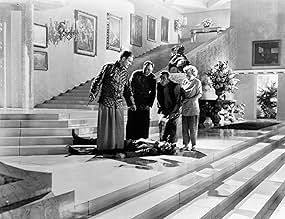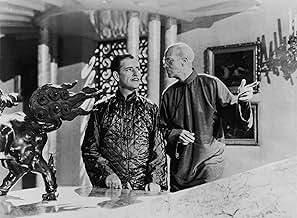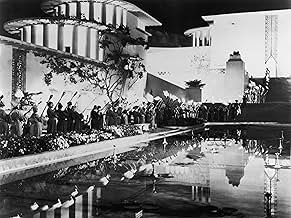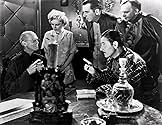AVALIAÇÃO DA IMDb
7,6/10
15 mil
SUA AVALIAÇÃO
Um acidente de avião leva um grupo de pessoas para a terra isolada de Shangri-La, mas é a utopia miraculosa que parece ser?Um acidente de avião leva um grupo de pessoas para a terra isolada de Shangri-La, mas é a utopia miraculosa que parece ser?Um acidente de avião leva um grupo de pessoas para a terra isolada de Shangri-La, mas é a utopia miraculosa que parece ser?
- Direção
- Roteiristas
- Artistas
- Ganhou 2 Oscars
- 6 vitórias e 6 indicações no total
Norman Ainsley
- Embassy Club Steward
- (não creditado)
Chief John Big Tree
- Porter
- (não creditado)
Wyrley Birch
- Missionary
- (não creditado)
Beatrice Blinn
- Passenger
- (não creditado)
Hugh Buckler
- Lord Gainsford
- (não creditado)
Sonny Bupp
- Boy Being Carried to Plane
- (não confirmado)
- (não creditado)
John Burton
- Wynant
- (não creditado)
Tom Campbell
- Porter
- (não creditado)
Matthew Carlton
- Pottery Maker
- (não creditado)
- Direção
- Roteiristas
- Elenco e equipe completos
- Produção, bilheteria e muito mais no IMDbPro
Avaliações em destaque
"I believe it because I want to believe it". This one line speaks volumes about what the movie (and the original novel) was trying to say. The concept of Shangri-La, a place where people work and live in peaceful harmony, is as relevant today as it was in the post-World War I era that James Hilton wrote 'Lost Horizon', where the world was still in turmoil following a devastating war and another was on its way.
In these days of war, humanitarian devastation and disease, how many people are there who dream of getting away from it all and living out their lives in a remote paradise just like Shangri-La? The High Lama's words to Conway resonate strongly even today.
"Look at the world today. Is there anything more pitiful? What madness there is! What blindness! What unintelligent leadership! A scurrying mass of bewildered humanity, crashing headlong against each other, propelled by an orgy of greed and brutality." On a more cinematographic note, the movie is visually stunning in an age before CGI and astronomical budgets. The beauty of Shangri-La, the stunning mountain landscapes and the overall settings of the movie make us believe that such a wonderful place can exist. All the actors are commendable in their portrayals (though some characters are different to those in the original novel) and their interaction with each other add a real sparkle to the movie.
'Lost Horizon' is a beautiful adaptation of James Hilton's masterpiece and captures the very feeling of the novel and I would highly recommend it to anyone who has ever dreamed of escaping from the hectic world in which we live.
In these days of war, humanitarian devastation and disease, how many people are there who dream of getting away from it all and living out their lives in a remote paradise just like Shangri-La? The High Lama's words to Conway resonate strongly even today.
"Look at the world today. Is there anything more pitiful? What madness there is! What blindness! What unintelligent leadership! A scurrying mass of bewildered humanity, crashing headlong against each other, propelled by an orgy of greed and brutality." On a more cinematographic note, the movie is visually stunning in an age before CGI and astronomical budgets. The beauty of Shangri-La, the stunning mountain landscapes and the overall settings of the movie make us believe that such a wonderful place can exist. All the actors are commendable in their portrayals (though some characters are different to those in the original novel) and their interaction with each other add a real sparkle to the movie.
'Lost Horizon' is a beautiful adaptation of James Hilton's masterpiece and captures the very feeling of the novel and I would highly recommend it to anyone who has ever dreamed of escaping from the hectic world in which we live.
I watched this film for the first time as a 10 year old and its effects on my willingness to be a optimistic idealist have always been led by my memories of this hope inspiring tribute to the need for the human being to find Heaven in this life. Perhaps Lost Horizon could have been that spark that enabled me to find just that. Like all films from another era do not judge this film for its apparent imperfections, rather for what it offered the audiences of that time (1937), hope that all would be well when man would recognize that his time is always better spent broadening his horizons of understanding. Frank Capra's guides his audiences through danger and turmoil to that place which dreams are made of, when we all make the effort to make it happen.
Frank Capra classic about a group of British citizens, led by diplomat Robert Conway (Ronald Colman), who flee a rebellion in China only to have their plane crash in the Himalayas. They are taken to Shangri-La, a magical place isolated in the mountains where people can leave behind the worries of civilization. They learn they will live for hundreds of years there but only if they never leave. The world-weary Conway is intrigued by the promise of this utopia but not everyone in his group feels the same way.
It's an ambitious undertaking for Capra, who made no other movies on the scale of this one (or with the budget). The costumes and Art Deco sets are beautiful. Great script from Robert Riskin, adapted from James Hilton's novel. Lovely, haunting score from Dimitri Tiomkin. Ronald Colman, an exceptional actor who never did a bad job that I've seen, gives a moving, sincere performance that ranks among the best of his impressive career. Sam Jaffe is also excellent in his small but important role as the High Lama. The rest of the wonderful cast includes John Howard, Jane Wyatt, Edward Everett Horton, H.B. Warner, Isabel Jewell, and Thomas Mitchell (the first of four movies he did with Capra). Jane Wyatt's swimming scene is probably the sexiest thing she ever did on film. The opening scenes are exciting and the climax is powerful. The middle of the film is where many people complain that it's slow or that it loses focus. I admit there is a chunk of the middle of the film, dealing with Colman and Wyatt falling in love, as well as everyone adjusting (or not adjusting) to Shangri-La that drags just a bit. But I never felt bored and I don't think it derails the film at all. The dialogue and performances in these scenes is still great. The original cut ran much longer and I can only imagine whether that version would be better or worse. As it is, seven minutes of footage is still missing from the current version. The dialogue for these scenes is intact, with production stills in place of the missing footage.
It's escapism, pure and simple. Many viewers will poke holes in the idea and philosophy behind Shangri-La, calling it naive and childish. Perhaps they're right; perhaps the cold, cynical reality of selfish human nature means such a utopia is impossible. But the thing about most of Frank Capra's films, and why he is probably my favorite director ever, was that he believed in telling uplifting, optimistic stories about us helping each other overcome our baser nature; that good can triumph over evil and there are such things as happy endings. While Lost Horizon is not really one of his "Capra-corn" movies, I think the basic Capra elements are still there, right down to the final shot. Most other directors would have likely gone for the sad or tragic ending, but Capra gives us one that is hopeful.
It's an ambitious undertaking for Capra, who made no other movies on the scale of this one (or with the budget). The costumes and Art Deco sets are beautiful. Great script from Robert Riskin, adapted from James Hilton's novel. Lovely, haunting score from Dimitri Tiomkin. Ronald Colman, an exceptional actor who never did a bad job that I've seen, gives a moving, sincere performance that ranks among the best of his impressive career. Sam Jaffe is also excellent in his small but important role as the High Lama. The rest of the wonderful cast includes John Howard, Jane Wyatt, Edward Everett Horton, H.B. Warner, Isabel Jewell, and Thomas Mitchell (the first of four movies he did with Capra). Jane Wyatt's swimming scene is probably the sexiest thing she ever did on film. The opening scenes are exciting and the climax is powerful. The middle of the film is where many people complain that it's slow or that it loses focus. I admit there is a chunk of the middle of the film, dealing with Colman and Wyatt falling in love, as well as everyone adjusting (or not adjusting) to Shangri-La that drags just a bit. But I never felt bored and I don't think it derails the film at all. The dialogue and performances in these scenes is still great. The original cut ran much longer and I can only imagine whether that version would be better or worse. As it is, seven minutes of footage is still missing from the current version. The dialogue for these scenes is intact, with production stills in place of the missing footage.
It's escapism, pure and simple. Many viewers will poke holes in the idea and philosophy behind Shangri-La, calling it naive and childish. Perhaps they're right; perhaps the cold, cynical reality of selfish human nature means such a utopia is impossible. But the thing about most of Frank Capra's films, and why he is probably my favorite director ever, was that he believed in telling uplifting, optimistic stories about us helping each other overcome our baser nature; that good can triumph over evil and there are such things as happy endings. While Lost Horizon is not really one of his "Capra-corn" movies, I think the basic Capra elements are still there, right down to the final shot. Most other directors would have likely gone for the sad or tragic ending, but Capra gives us one that is hopeful.
The second half of the 1930s saw the return of the big picture - bigger budgets, grander ideas, longer runtimes in which to tell a story. But the 30s were also a decade of highly emotional and humanist cinema, fuelled by the hardships of the great depression. Lost Horizon sees what was for the time a rare marriage between burgeoning picture scope, in what was "poverty row" studio Columbia's most expensive production to date, and poignant intimacy in the source novel by James Hilton.
Thank goodness for director Frank Capra, who seemed really able to balance this sort of thing. Capra could be a great showman, composing those beautiful iconic shots to show the magnificent Stephen Goosson art direction off to best advantage. But he also knows how to bring out a touching human story. In some places Capra's camera seems a trifle distant, and is almost voyeuristic as it peeps out through foliage or looming props. But rather than separate us from the people it is done in such a way as to give a kind of respectful distance at times of profound emotion, for example when Ronald Colman comes out of his first meeting with the High Lama. The camera hangs back, just allowing Colman's body language to convey feelings. At other times Capra will go for the opposite tack, and hold someone in a lengthy close-up. In this way we are given to just one facet a character's emotional experience, and it becomes all the more intense for that.
Of course such techniques would be nothing without a good cast. There couldn't really have been anyone better than Ronald Colman for the lead role. Now middle-aged, but still possessed with enough charm and presence to carry a movie, Colman has a slow subtlety to his movements which is nevertheless very expressive. His face, an honest smile but such sad eyes, seems to be filled with all that hope and longing that Lost Horizon is about. Sturdy character actors H.B. Warner and Thomas Mitchell give great support. It's unusual to see comedy player Edward Everett Horton in a drama like this, and comedy players in dramas could often be a sour note in 1930s pictures, but Horton is such a lovable figure and just about close enough to reality to pull it off. The only disappointing performance is that of John Howard, who is overwrought and hammy, but even this works in a way as it makes his antagonistic character seem to be the one who is out of place.
Lost Horizon is indeed a wondrous picture, and one that fulfils its mission statement of being both sweeping and soul-stirring. It appears that Capra, always out for glory, was out to make his second Academy Award Best Picture. But history was to repeat itself. In 1933 he had had his first go at a potential Oscar-winner with The Bitter Tea of General Yen, only for that picture to be ignored and the more modest It Happened One Night to win the plaudits the following year. Lost Horizon won two technical Oscars, but bombed at the box office, but in 1938 the down-to-earth comedy drama You Can't Take it with You topped the box office and won Best Pic.
Lost Horizon was in no way worthy of such a dismissal, and is indeed a bit better than You Can't Take it with You. It was perhaps more than anything a case of bad timing. Audiences were only just starting to get used to two-hour-plus runtimes, especially for movies with such unconventional themes. If you look at contemporary trailers and taglines, you can see it was being pitched as some kind of earth-shattering spectacular, whereas it is more in the nature of an epic drama. For later releases the movie was edited down to as little as 92 minutes. Fortunately, we now have a restored version. The additional material that has been reconstructed is vital for giving depth, not only to the characters, but also to the setting of Shangri-La itself. With hindsight, we can look back on Lost Horizon as a work of real cinematic beauty.
Thank goodness for director Frank Capra, who seemed really able to balance this sort of thing. Capra could be a great showman, composing those beautiful iconic shots to show the magnificent Stephen Goosson art direction off to best advantage. But he also knows how to bring out a touching human story. In some places Capra's camera seems a trifle distant, and is almost voyeuristic as it peeps out through foliage or looming props. But rather than separate us from the people it is done in such a way as to give a kind of respectful distance at times of profound emotion, for example when Ronald Colman comes out of his first meeting with the High Lama. The camera hangs back, just allowing Colman's body language to convey feelings. At other times Capra will go for the opposite tack, and hold someone in a lengthy close-up. In this way we are given to just one facet a character's emotional experience, and it becomes all the more intense for that.
Of course such techniques would be nothing without a good cast. There couldn't really have been anyone better than Ronald Colman for the lead role. Now middle-aged, but still possessed with enough charm and presence to carry a movie, Colman has a slow subtlety to his movements which is nevertheless very expressive. His face, an honest smile but such sad eyes, seems to be filled with all that hope and longing that Lost Horizon is about. Sturdy character actors H.B. Warner and Thomas Mitchell give great support. It's unusual to see comedy player Edward Everett Horton in a drama like this, and comedy players in dramas could often be a sour note in 1930s pictures, but Horton is such a lovable figure and just about close enough to reality to pull it off. The only disappointing performance is that of John Howard, who is overwrought and hammy, but even this works in a way as it makes his antagonistic character seem to be the one who is out of place.
Lost Horizon is indeed a wondrous picture, and one that fulfils its mission statement of being both sweeping and soul-stirring. It appears that Capra, always out for glory, was out to make his second Academy Award Best Picture. But history was to repeat itself. In 1933 he had had his first go at a potential Oscar-winner with The Bitter Tea of General Yen, only for that picture to be ignored and the more modest It Happened One Night to win the plaudits the following year. Lost Horizon won two technical Oscars, but bombed at the box office, but in 1938 the down-to-earth comedy drama You Can't Take it with You topped the box office and won Best Pic.
Lost Horizon was in no way worthy of such a dismissal, and is indeed a bit better than You Can't Take it with You. It was perhaps more than anything a case of bad timing. Audiences were only just starting to get used to two-hour-plus runtimes, especially for movies with such unconventional themes. If you look at contemporary trailers and taglines, you can see it was being pitched as some kind of earth-shattering spectacular, whereas it is more in the nature of an epic drama. For later releases the movie was edited down to as little as 92 minutes. Fortunately, we now have a restored version. The additional material that has been reconstructed is vital for giving depth, not only to the characters, but also to the setting of Shangri-La itself. With hindsight, we can look back on Lost Horizon as a work of real cinematic beauty.
Many people may not be drawn to a film like this because it doesn't involve a lot of conflict, and that lack of conflict does make it slow-going at times, but it's still a beautiful film. The sets are wonderfully designed for a modestly budgeted (though it was a big budget at the time) motion picture. Ronald Coleman is a terrific actor, with a dominant screen presence and a certain strength in his voice. The film delivers a good deal of life lessons, and Shangri-La really does look like a great place to live. They believe in doing everything "in moderation," which is a fine philosophy. No wars, very little conflict, everyone's in good health. Can't complain about a place like that. The ending is especially poignant. One minor flaw is the lack of development of the prostitute. She's the only character who doesn't have an arc, and holds much contempt throughout the whole film. I wanted to know the source of her contempt. I never gathered why she was so whiny.
If you want to see a beautiful, feel-good movie with great performances, then "Lost Horizon" is the one to see.
My score: 7 (out of 10)
If you want to see a beautiful, feel-good movie with great performances, then "Lost Horizon" is the one to see.
My score: 7 (out of 10)
Você sabia?
- CuriosidadesThe year after this film was released the owner of a prosperous theater chain hired an architect who designed a mansion that was inspired by the Shangri-La lamasery in this film. Located in Denver, Colorado, it still exists today.
- Erros de gravaçãoEchoing the words of the critic, James Agate: 'The best film I've seen for ages, but will somebody please tell me how they got the grand piano along a footpath on which only one person can walk at a time with rope and pickaxe and with a sheer drop of three thousand feet or so?'
- Cenas durante ou pós-créditosBob Gitt of the UCLA Film & Television Archives claims the original opening sequence in 1937 had title cards "Conway has been sent to evacuate ninety white people before they're butchered in a local revolution" was changed in 1942 for a special reissue during WWII. The title cards read "before innocent Chinese people were butchered by Japanese hordes." This was to bolster propaganda against the Japanese.
- Versões alternativasSome of the music in the restored version is dubbed into different sections than the ones in the 118 minute cut version. For example, the moment in which Robert Conway ('Ronald Colman') discovers that the High Lama is really Father Perrault i accompanied by soft music in the cut version, while in the restored version this moment is played with no music.
- ConexõesEdited from Stürme über dem Mont Blanc (1930)
- Trilhas sonorasWiegenlied (Lullaby) Op. 49 No. 4
(1868) (uncredited)
Composed by Johannes Brahms
English translator unknown
Sung a cappella by children at Shangri-La
Principais escolhas
Faça login para avaliar e ver a lista de recomendações personalizadas
Detalhes
- Data de lançamento
- País de origem
- Central de atendimento oficial
- Idiomas
- Também conhecido como
- Horizontes Perdidos
- Locações de filme
- Empresa de produção
- Consulte mais créditos da empresa na IMDbPro
Bilheteria
- Orçamento
- US$ 4.000.000 (estimativa)
- Tempo de duração2 horas 12 minutos
- Cor
- Proporção
- 1.37 : 1
Contribua para esta página
Sugerir uma alteração ou adicionar conteúdo ausente


































